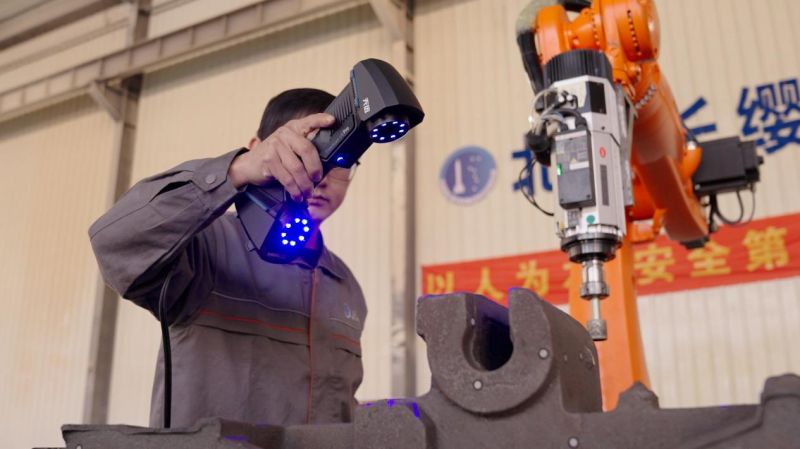
CASE STUDIES
Published on Apr. 10th 2024
3D Scanning for Robotic Path Planning with The SHINING 3D FreeScan Series
A SHINING 3D client (confidential) has been using 3D scanning for robotic path planning as an alternative to manual point identification and placement. It enables the team to further automate the post-processing of their medium to large-sized castings.
About the Client
- Company Confidential
- Service Casting production
- Need Robotic Path Planning
- Solution SHINING 3D FreeScan Series
This case study is also available on YouTube:
Introduction
Industrial automation has been a hot topic for several decades, and now more than ever. Machines are gradually replacing manual labor in high-intensity operations.
This is the case at SHINING 3D client’s casting production factory, where industrial robots conduct most welding operations. They sought to automate their casting grinding process, as well.
To do so, they incorporated high-accuracy 3D scanning technology into their workflow.
Context and Pain Points
In the production process, castings often develop defects such as burrs and sand inclusion. These surface imperfections require grinding, i.e., “sanding” them with an abrasive disk or belt.
 Grinding a metallic casting to eliminate defects.
Grinding a metallic casting to eliminate defects.
Using robots for this process is relatively mature on small-sized parts. However, for medium to large-sized castings, manual grinding is still predominant. Consequently, our client thus installed an industrial grinding robot to save time and perform more accurate grinding than what could be done manually.
However, one step remained manual: placing points on the casting in alignment with its CAD drawings. This task is essential for robot path planning, as each part varies in dimensions and shapes.
The company needed a more efficient way to capture part dimensions and geometries to accelerate the robotic path planning process.

Discover the product you're looking for
- Full specifications
- Using scenarios
- Key features
- Even comes with a bundle!
3D Scanning for Robotic Path Planning
With the aid of FreeScan UE Pro, employees can now obtain complete and high precision 3D data of each casting and quickly import it into CAM software for robot path planning.
 A comprehensive 3D data set from one of the company’s castings.
A comprehensive 3D data set from one of the company’s castings.
Quicker robotic path planning is not the only benefit the team has gained, moreover, they can also now compare the 3D scan data with the casting’s original design file.
This enables them to identify casting size deviations and obtain even more accurate path planning. They can, for example, determine the exact grinding thickness the robot must apply to get the perfect surface.
 A screenshot from the client’s robot motion planning software.
A screenshot from the client’s robot motion planning software.
According to the company’s head of Intelligent Manufacturing, integrating high-precision 3D scanning technology plays a significant role in the success of their automated grinding solution. “In the stage of robotic path planning, 3D scanning allows one engineer to complete the task instead of two, and with increased efficiency,” they pursued.
Why Choose SHINING 3D’s FreeScan UE Pro
The FreeScan UE Pro is a good fit for this client because of its high precision, efficiency, and portability:
● Precision: With an accuracy of 0.02mm and stable repeatability, it ensures that the CAM software has precise information to plan robot paths.
*Note: The FreeScan Series is ISO 17025 certified, following VDI/VDE 2634 Part 3 standards. This involves evaluating detection error performance based on traceable sphere diameter measurement data. Measurements are conducted from multiple perspectives within the working range using traceable length standards to assess sphere-to-sphere spacing errors. Volumetric accuracy can also be further optimized through build-in photogrammetry.
● Efficiency: The FreeScan UE Pro can achieve an impressive scanning speed of up to 3.5 million points per second. For a 1-meter-long casting, this translates into just 5 minutes of scanning.
● Portability: This laser 3D scanner is handheld and can be used directly on the production line; there’s no need to dismount castings that are already up.
 An engineer using the handheld 3D scanner directly on the production line.
An engineer using the handheld 3D scanner directly on the production line.
For more information, please visit the FreeScan UE Pro presentation page.
Conclusion
Using 3D scanning for robotic path planning has helped our client gain efficiency and precision within their casting grinding process. The team can use the FreeScan UE Pro directly on each casting and obtain precise data in minutes.
They can then export the data topath planning software and program more precise grinding, for better-quality finishes oncastings.
Are you ready to upgrade your robotic path planning workflow with 3D scanning technology? Contact our team today to see how the SHINING 3D FreeScan Series can meet your requirements.

FreeScan UE Pro
FreeScan UE Pro equips high-precision, metrology-grade accuracy and lightweight design while improving the ability to fine-scan and global precision control large-scale workpiece scanning.
- Metrology-Grade High Accuracy
- Global Precision Control
- Multiple Scanning Modes
